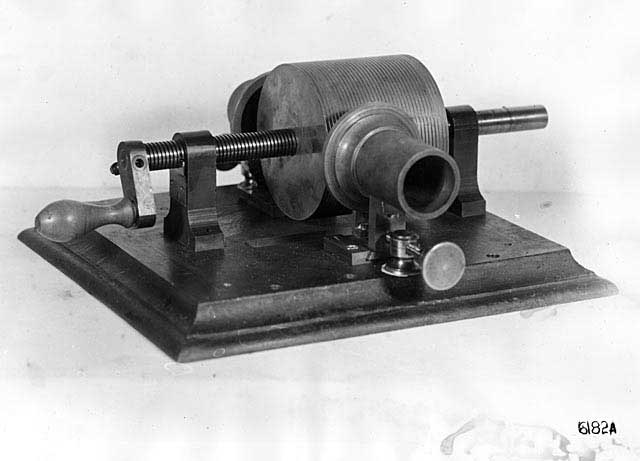The Phonograph over time...




Summary
In 1877, while Thomas Alva Edison was working on two of his inventions, the telegraph and telephone, he accidentally discovered the ability to reproduce sound. This discovery led to the invention of the phonograph. The original phonograph was considered an “early sound-reproducing machine that used cylinders to record as well as reproduce sound.”[3] The phonograph is defined as "an instrument for reproducing sounds by means of the vibration of a stylus or needle following a spiral groove on a revolving disc or cylinder".[4] The phonograph was a pivotal discovery and invention in the field of communication. While the original intent for the phonograph was to be used in the business industry it evolved over the past decades into the world of entertainment. Little did Edison know that the phonograph would evolve into something so entertaining.
History
The earliest evidence on record of the invention of the phonograph “was on paper by French Scientist Charles Cros, written on April 18, 1877.”[1] However, the true inventor of the phonograph is recognized as Thomas Edison. While Edison was working on two of his other inventions, the telegraph and telephone, he found that telegraphic messages could be indented on paper tape then repeatedly sent over the telegraph. It was just a matter of time when he realized that telephone messages could be recorded and relayed in the same manner.
Edison’s first attempt at the phonograph was an experiment with a diaphragm with an embossing point that was held against a rapid moving paraffin paper; causing indentations on the paper. Later, he replaced the paper to a cylinder made of metal covered with tin foil. This new device had two diaphragms and two needles, one for recording and want for playing back. When speaking into the diaphragm, the sound vibrations would cause the needle to form indented grooves on the cylinder. A sketch of the machine was then given to Edison’s mechanic, John Kruesi who built the first phonograph. Edison enthusiastically tested the machine by “speaking the nursery rhyme into the mouthpiece, “Mary had a little lamb””.[] He was amazed that the machine repeated his words back as they had been recorded.
http://youtu.be/2IF0mgyfm54?hd=1
Over the next several decades, improvements and new discoveries were found that not only improved the quality of sound that could be recorded but the manner in which it was recorded. It was no longer seen as a "voice recorder", it opened the door to talking dolls, coin-slot machines that eventually became known as the jukebox. By the nineteenth century there were many rivals designing and improving the phonograph such as "Emile Berliner, whom created a flat, hard shellac disc with better sound quality and could be stored more easily than the wax cylinder"; eventually replacing Edison's phonograph.[1]
http://youtu.be/bv2D-xE1yjA?t=41m15s
Critics of the Phonograph
Music and how it is recieved has changed over the past 100 years. Many suggest that the invention of the phonograph eliminated the intimate relationship between music, the artist and its listeners. John Philip Sousa was one of the biggest critics of recorded music. Sousa predicted that recordings would be the end to music. "The phonograph, he warned, would erode the finer instincts of the ear, end amateur playing and singing, and put profession musicians out of work".[3] "Something is irretrievably lost when we are no longer in the presence of bodies making music".[3] As recording of music increased, the question of authenticity became greater. Robert Philip, another critic of recording music, states that "technology fundamentally altered the tradition that it was intended to preserve".[3] Ross suggests that recordings captured by the phonograph "can preserve those forever disappearing moments of sound but never the spark of humanity that generates them".[3]
Phonograph in Today's World
Implications on Media Ecology
The phonograph was a pivotal discovery and invention in the field of communication.
References:
[1] Encyclopedia of Communication and Information STEPHEN D. PERRY . Ed. Jorge Reina Schement . Vol. 1. New York: Macmillan Reference USA, 2002.
[2] Dictionary of American History Ron Briley . Ed. Stanley I. Kutler . Vol. 1. 3rd ed. New York: Charles Scribner's Sons, 2003.
[3] Ross, Alex. "How technology has transformed the sound of music." The Record Effect. N.p.: n.p., n.d. 1-17. Web. 11 Dec. 2012. <http://iwcmediaecology.pbworks.com/w/file/fetch/61464677/Ross_The%20Record%20Effect.pdf>.
[4]"Phonograph." Merriam-Webster Dictionary. Online ed. n.d. N. pag. Web. 10 Dec. 2012. <http://www.merriam-webster.com/dictionary/phonograph>.
[1]Gitelman, Lisa. Always Already New . Cambridge: The MIT Press, 2006.
[2]"History of the Phonograph." American Jukeboxes. 23 Dec. 2008 http://www.americanjukeboxes.com/site/620909/page/877262.
[3]"Phonograph." Encyclopædia Britannica. 2008. Encyclopædia Britannica Online. 15 Dec. 2008 <
[4]Schoenherr, Steven. "Recording Technology History." . 6 July 2005. 23 Nov. 2008 http://history.sandiego.edu/GEN/recording/notes.htm.
instrument for reproducing sounds by means of the vibration of a stylus, or needle, following a groove on a rotating disc. A phonograph disc, or record, stores a replica of sound waves as a series of undulations in a sinuous groove inscribed on its rotating surface by the stylus. When the record is played back, another stylus responds to the undulations, and its motions are then reconverted into sound."
Comments (0)
You don't have permission to comment on this page.